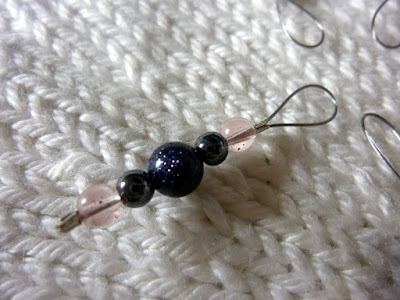How should I pick my first pattern?
For your first sock, find a plain (stockinette stitch or garter stitch) pattern with sport or worsted weight yarn like this cuff down pattern "Socks 101" by Larissa Brown or this "Simple Toe Up Anklets" by Rachel Calado (the only thing I'd change for beginners is that I'd use a set of double pointed needles -- dpns -- instead). Either pattern will knit up quick and give you the basic construction techniques to build the confidence to work on more complex sock patterns. After you complete your first plain pair (or two pairs --- one of each technique), most other sock patterns will then just add different stitch patterns which depend on your experience level.
Toe Up or Cuff Down? --- Does it matter?
In a nutshell, no. There are two methods for constructing your own socks that basically depend on which end you start at, cuff down or toe up. Neither method is more complicated but typically knitters will have a clear preferance because of the techniques involved that can be initially scary and very different for the aspiring sock knitter. Top down socks you'll have to deal with Kitchener stitch, picking up stitches and gussets where as toe up you'll probably deal with short rows and basic increases/decreases. Youtube is the best for visual learning but also check out techknitter's blog --- she's great for preventing/correcting issues and multiple variations.
Either direction you work the sock, you'll be knitting in the round with double pointed needles (dpns) or circular needles (magic loop method uses one circular needle or you can use two circular needles). I recommend starting with dpns. Frequently knitters use two circular needles to knit two socks at the same time. Although this method may seem slow, your socks are garenteed to match row for row. Less known, dpns can actually be used to knit two socks at a time, one inside the other and this looks really cool (check out my youtube links to see what that looks like and how to do other techniques).
Where do I go from here?
When you feel ready after completing your first pair of plain socks, I highly recommend looking into the following designers/books. As with any other pattern, make sure you have all the errata before you start. Some patterns will not have errata printed but you'll find it in project notes of other completed projects on Ravelry -- just sort the patterns by helpful notes first. Also you might also find pattern modications or color schemes you haven't thought of but prefer.
- Cookie A wrote a couple of amazing books (Sock Innovation and recently published, Knit. Sock. Love.) and some of the designs are stellar if you're comfortable or want to be comfortable with lace and cables. I love her explanations on construction and inspiration.
- The Joy of Socks is one of my favorite sock books. It's a collection from mulitple designers and the patterns use a multitued of different techniques garenteed to build your knitting skills.
- The free eZine Knitty has some great ones as well: Here are a few:
- Skew
- Blackrose Socks
- Double Heelix
- Garden Gate
- Pomatomus (this is one of Cookie A's free patterns if you want sample one of her patterns)
- Lingerie
- Maeva
- Celtic Triad










